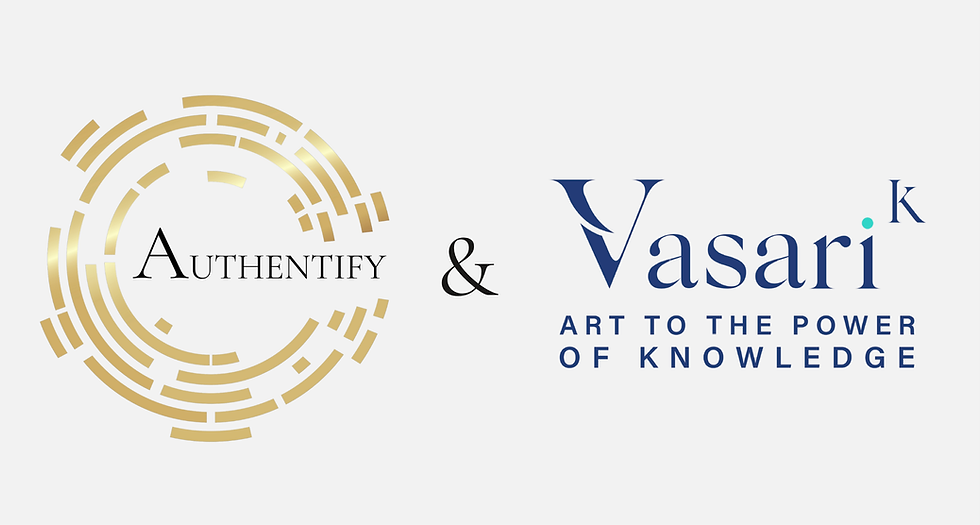Truth, Trust, and the Tag: Why the Art Market Needs Infrastructure, Not Hype
- Theo Johns

- May 1
- 4 min read
Over the last few years and my discussions with all leaders in the Art Industry and listening to them, I found myself reflecting on one simple but pressing truth: the art world is in a state of deep contradiction. On one hand, it’s global, digital, and faster than ever. On the other, it remains opaque, analogue, and dangerously reliant on trust without tools. The question that emerged — and one we must all answer — is this: can the art world evolve without losing its soul?
At a time when wealth is concentrated, hype outpaces merit, and the pressure for constant production stifles creative longevity, the art ecosystem is struggling to maintain its integrity. The increasing professionalization of the art market, coupled with its commodification, has turned many artists into “one-hit wonders,” forced to innovate on demand for an audience hungry for novelty but starved of nuance. Meanwhile, the critical apparatus that once defined artistic value has eroded, replaced by Instagram likes and auction house PR.
Amidst this cultural pressure cooker, a more technical but no less urgent crisis has emerged: the art market lacks infrastructure. Not metaphorically — literally. We have no universal registry, no standard for title, no clear system for provenance or due diligence. Art is being flipped, pledged, stored, stolen, and sold with little more than PDFs, promises, and private Excel files. And when things go wrong — as they did in the case of the Henry Gibbs painting looted by the Nazis or the Lisa Schiff investment scandal — the market recoils, then resumes.
It’s not enough to ask for more transparency. We must build it.
A New Infrastructure for a Trustworthy Art World
At Authentify Art, we believe the solution starts by anchoring every artwork to a secure, unbreakable digital identity — a “truth tag” if you will — physically attached to the object and digitally linked to a secure, permissioned dossier that evolves over time.
This is not blockchain vaporware or buzzword tech.
It’s RFID, NFC, sensors, and cloud-based intelligence — deployed and active today in galleries, logistics firms, and private collections across Europe and the U.S.
Our system is built around three strategic pillars:
Operational Modernization
From gallery basements to museum vaults, most art inventory systems are outdated. Manual barcodes. Incomplete spreadsheets. No real-time tracking.
Authentify automates this.
Our RFID tagging system enables hands-free inventory checks.
Handheld and fixed readers update object locations instantly.
Our Lost & Found alert engine identifies missing works in seconds — without opening a crate
Our platform integrates directly into existing workflows, offering real-time visibility and alerting for artworks entering or exiting storage zones
Risk Mitigation
In today’s regulatory climate, risk isn’t just about theft — it’s about sanctions, fraud, title disputes, and asset-based lending.
With our partners (including Articheck, Smartcosmos, and VasariK), we help mitigate risk by:
Verifying authenticity and attribution using scientific and peer-reviewed documentation
Flagging liens, loans, and disputed ownership through our digital Art Passport
Running automated KYC/AML screening for dealers and collectors
Recording movement, environmental data, and custody chains for insurance compliance
We don’t just protect artworks — we protect the transactions and reputations surrounding them.
Data Management
Art lives longer than institutions. It needs a digital legacy that survives generations. Our platform serves as a living archive for:
Provenance, bibliography, exhibitions, and condition reports
AI-enhanced insight engines for research and market visibility
A secure, permissioned sharing system for customs, appraisers, insurers, or future heirs
Carbon tracking and environmental audit trails — essential in today’s climate-conscious landscape
Our data is not just secure — it is structured to feed the next generation of AI in art. Because if artificial intelligence is trained on bad data, it simply becomes a more efficient version of the problem.
Standardizing Trust: The 8 A’s of Art
The diamond industry has the 4 Cs. At Authentify, we believe the art market deserves its own standard of clarity — and we’ve built it:
The 8 A’s of Art — Authentify’s Due Diligence Framework
Attribution: Authorship & connoisseurship supported by catalogues raisonnés and expert analysis.
Acquisitions: Provenance and sales records including ownership chains, auction history, and institutional affiliations.
Archives: Scholarly references, rare books, primary documents, diaries, and articles contributing to intellectual depth.
Appearances: Exhibition history in museums, galleries, auctions, and traveling shows that establish credibility.
Authenticity: Scientific analysis, authentication reports, and material verification.
Agreements: Legal documents covering sales, copyright, loans, insurance, and liens.
Assessment: Condition reports, restoration history, and environmental data.
Activity: Logistics, movement tracking, tag interactions, customs, and proof of life data.
Each of these is a pillar of our secure scorecard system — a transparent, modular format that even a layman can understand. It brings accountability without complexity, and democratizes knowledge in an industry long shielded by gatekeeping.
A Vision Aligned with Tradition, Enabled by Tech
In many ways, this vision is not disruptive — it’s restorative. It brings back the old values of slow looking, careful curation, and verifiable truth — but with 21st-century tools and protections.
As Sylvain Levy recently shared in his talk at Sotheby’s Institute: “Art should dismantle consensus, not collude towards it.” But to do that, we need a structure that protects artists from exploitation, protects collectors from fraud, and protects art itself from being reduced to speculative noise.
Authentify does not sell hype. We build infrastructure.
We are not another app or SaaS tool. We are the backbone of a trusted and truthful art world — one that can scale, sustain, and survive.
The time is now.
The art world doesn’t need another market trend. It needs infrastructure. It needs trust.
It needs a tag, a dossier, and a platform that can stand the test of time.


